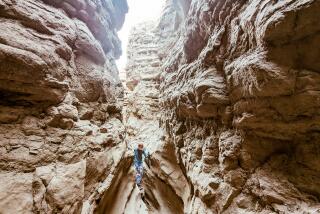CLIPBOARD : SADDLEBACK MOUNTAIN
- Share via
In a 1930s book entitled “Shadows of Old Saddleback,” author Terry E. Stephenson wrote of Saddleback Mountain: “Though Old Saddleback is made up of two peaks, the crests of which lie almost exactly a mile apart, to the old-timers it was always one mountain, and to the casual observer of today it appears as one mountain.”
Saddleback Mountain, an imposing silhouette on the eastern horizon, is not an official name. However, its two summits are noted on maps and accounted for in U.S. Geological Surveys. Standing at an elevation of 5,687 feet, Santiago Peak is the highest point in the county. The northern dome, Modjeska Peak, lacks rival Santiago’s height (it’s just 5,496 feet) but it has a more interesting past.
At the edge of the Santa Ana Mountains, Modjeska Canyon Road winds through canyon hillsides and climbs past homes that have been a part of the scenery since the beginning of this century. One of the oldest homes belonged to Shakespearean actress Madame Helena Modjeska, after whom the peak is named.
Built in 1888, the Modjeska House is now being remodeled and is a center of controversy for the rural dwellers of the Old Saddleback community. County officials purchased the house in 1986 and plan to lease the space for wedding receptions and parties, but neighbors of the historic landmark fear a traffic problem and alcohol-related accidents.
“This is our home, and we’ve been upset about the prospect of big crowds and traffic,” said 14-year resident Suzanne Holt.
While the building is undergoing renovations, county officials are conducting an environmental impact study and working out any disagreements with residents of the closely knit community.
The home, which Modjeska named Arden because the scenery reminded her of the Forest of Arden as described by Shakespeare in his play “As You Like It,” invokes a feeling of quiet, gracious luxury. Walking the grounds, thick with alder trees, one can imagine the Polish actress entertaining famous guests, including Nobel prize-winner Henryk Sienkiewicz, author of “Quo Vadis.” Aside from attending the parties and picnics so popular in the area, Sienkiewicz was reported to have joined expeditions to hunt grizzly bear in the canyon.
Old Saddleback provided one of the last refuges for the state symbol, the grizzly bear. Today, Tucker Wildlife Sanctuary provides a refuge for mule deer, mountain lions, ring-tailed cats and rattlesnakes. But back in the 1880s, other varmints, the two-legged kind, preferred to inhabit Santiago Peak.
Santiago Peak had a wild reputation as a home for mining camps and a crossing ground for horse thieves. A path still known as Horsethief Trail was used by rustlers to run stolen horses across the Santa Ana Mountains. However, area Indians revered Kalawpa, meaning wooded place, named after the Coulter pines and California maple trees found near the peak’s summit. Indian lore holds that Kalawpa was the resting place of the great god Chimingchinish, who watched over the people in the valleys below.
Today, Santiago Peak is a forest of microwave relay towers. From the top of the mountain, the land below unfolds like a topographical map. Looking out to the west, tan-colored cliffs of Santa Catalina Island float in an emerald sea. To the south, purplish mountains of Northern Mexico and tall San Diego buildings stand against a blue horizon. And, looking east, a vista of snow-capped mountains paint a white landscape. Perhaps, while gazing out over the county below, one can invoke the presence of Chimingchinish.
Stephenson, in his book, noted: “The name (Saddleback) has never appeared on any map. It is just as well. No such thing as lettered wording can measure the meaning of the big mountain to those who have lived their lives within its shadow.”
More to Read
Sign up for The Wild
We’ll help you find the best places to hike, bike and run, as well as the perfect silent spots for meditation and yoga.
You may occasionally receive promotional content from the Los Angeles Times.






